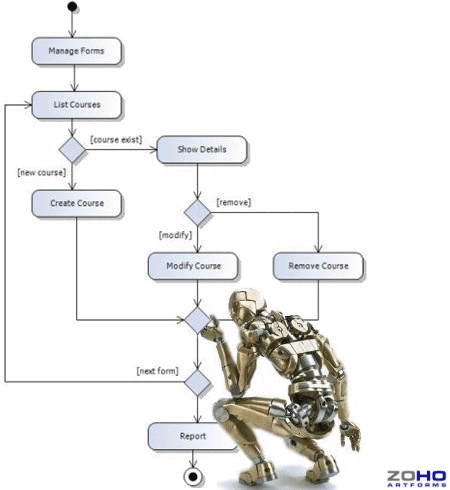Introduction
With Camano it is possible to have the fun of on-the-fly testing and still report reproducible bug reports. Combining Camano with TMap® makes it possible for us (Managed Testing Services of Sogeti) to do result driven test assignments (agreements with the project management concerning time, budget and/or test coverage).
To explain the balance between structured and on-the-fly testing and how to use Camano in the test project, I’ve written a fictitious case:
- The case specifications: Course Administration application.
- Creating the basis structure for test coverage
- The choices concerning freedom versus more structure in the Camano steps.
Case specifications: Course Administration application
Let’s imagine we have a project for making an application for our Course Administration:
In the course administration department, modification forms come in concerning self made and/or bought courses. The head of the department receives the modification forms and passes them on to an employee of the department. Depending on the type of modification (changing, entering or deleting) a maintenance function for the course data is started. After the modification has been performed, the next form is executed. After performing all the forms, the employee provides the head of the department with a written report of completion. The functional specifications are presented in the next activity diagram:

Creating the basis structure for test coverage
On bases of the activity diagram Process Cycle test cases must be created (or generated; see my previous blog entry). If we choose for test depth level 2, this means that the basis test coverage contains 3 test paths (see the generated paths over here). The test cases can be entered (copy-paste) during the preparation phase into Camano.
Freedom versus more structure in the Camano steps
Depending on the business risks, it is advisable to test the interaction between the system and the user in more detail than only starting and/or using the functionality. Two questions have to be answered:
- Do we create these syntax and semantic test cases before or during the execution of the test?
- When the syntax and semantic test cases are created (often in the form of checklists), do we add these detailed test steps into Camano? Or do we refer in the Camano steps to these checklists (the first time the specific function is encountered)?
There is no general answer to these questions. Creating the test cases during execution means a lot of freedom, and putting the detailed test steps into Camano gives the most structure. Depending on the risks, the experience of the Generalist Testers, the available time, the need for a regression test set, etcetera….the choice must be made (and documented in the overall test plan)!
Either way there is no effect on the quality of the bug reporting, because the Microsoft Test Runner records the complete behavior of the Generalist Tester in a global structure as well as in a detailed structure of implemented test steps
Back to the entry: On-the fly testing with Camano

 Calendar
Calendar





